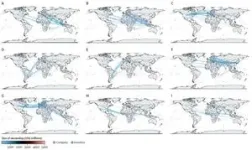(Press-News.org)
You need only to remember last summer’s wildfires in the United States and Canada, which fouled the air from coast to coast, to know the effects these blazes can have on the environment and human health.
A new study has tabulated the toll from two decades of wildfires on air quality and human health in the continental U.S. The authors report that from 2000 to 2020, the air has worsened in the western U.S., mainly due to the increase in frequency and ferocity of wildfires causing an increase of 670 premature deaths per year in the region during that time period. Overall, the study’s authors report fires have undercut successful federal efforts to improve air quality primarily through reductions in automobile emissions.
“Our air is supposed to be cleaner and cleaner due mostly to EPA regulations on emissions, but the fires have limited or erased these air-quality gains,” says Jun Wang, James E. Ashton professor and chair in the Department of Chemical and Biochemical Engineering, assistant director of the Iowa Technology Institute at the University of Iowa, and the lead corresponding author on the study. “In other words, all the efforts for the past 20 years by the EPA to make our air cleaner basically have been lost in fire-prone areas and downwind regions. We are losing ground.”
The researchers calculated the concentration of black carbon, a fine-particle air pollutant that has been linked to respiratory and heart disease, on a kilometer-by-kilometer (0.6 miles) grid for the continental U.S.
In the western U.S., the researchers report black carbon concentrations have risen 55%, on an annual basis, mostly due to wildfires.
Not surprisingly, the highest premature mortality rates were in the western U.S., the region where the wildfires originated or that was most affected by smoke from wildfires in Canada. The authors say the increase of 670 premature deaths per year is a conservative estimate, as black carbon’s effects on human health are not fully understood.
“Wildfires have become increasingly intensive and frequent in the western U.S., resulting in a significant increase in smoke-related emissions in populated areas,” Wang and his team write. “This has likely contributed to a decline in air quality and an increase in attributable mortality.”
The fires also have affected the Midwest. Smoke transported in the atmosphere affects air quality, though direct effects on health appear, for now, to be minimal. But, Wang says, “we are on the borderline. If fires increase or become more frequent, our air quality will get worse.”
The eastern U.S. had no major declines in air quality during the 2000-20 time period.
The researchers derived black carbon concentrations and premature deaths estimates from satellite data and 500 ground-based stations that monitor air quality. The data from surface stations can be extensive, but it does not give complete spatial coverage and can be lacking in rural areas. So, the researchers employed “deep learning,” which enables computer systems to cluster data and produce accurate predictions, to calculate the black carbon concentrations. They calculated premature deaths through a formula that incorporated average life span, black carbon exposure, and population density.
“This is the first time to look at black carbon concentrations everywhere, and at one-kilometer resolution,” Wang says.
Jing Wei, the study’s lead author, led the collection of satellite data of fine particulates and the analysis of these pollutants on public health when he was a postdoctoral research scholar in Wang’s research group at Iowa.
“The increasing number and intensity of wildfires in the U.S. counteract or even overshadow the reduction in anthropogenic emissions, exacerbating air pollution and heightening the risks of both morbidity and mortality,” says Wei, now assistant research scientist at the University of Maryland’s Earth System Science Interdisciplinary Center.
The study, “Long-term mortality burden trends attributed to black carbon and PM2.5 from wildfire emissions across the continental US from 2000-2020: a deep learning modelling study,” was published online Dec. 4 in the journal The Lancet Planetary Health.
Zhanqing Li, from the University of Maryland's Earth System Science Interdisciplinary Center, who supervises Wei, is a co-corresponding author. Contributing authors include Shobha Kondragunta, from the National Oceanic and Atmospheric Administration’s STAR Center for Satellite Applications and Research; Susan Anenberg, from George Washington University; Yi Wang and Huanxin Zhang, from Iowa; David Diner, from the California Institute of Technology and NASA Jet Propulsion Lab; Jenny Hand, from Colorado State University; Alexei Lyapustin, Ralph Kahn, Peter Colarco, and Arlindo da Silva, from NASA Goddard Space Flight Center; and Charles Ichoku, from the University of Maryland-Baltimore County.
NASA and NOAA funded the research.
END
Many emerging and re-emerging infectious diseases, especially zoonotic diseases such as ebola or new coronaviruses, emerge as the result of intensified human activities such as deforestation, expansion of agricultural land, and increased hunting and trading of wildlife.
In a new study, published in the scientific journal Lancet Planetary Health, researchers identified public and private companies operating in economic sectors associated with increased risks of emerging and re-emerging infectious diseases.
Where data was available, the researchers analyzed the financial ...
SYDNEY, Dec. 5, 2023 – Modern living may be contributing to an epidemic of nearsighted vision and related blindness. By 2050, it is estimated that half the world’s population will suffer from low vision due to myopia, a condition where the eye grows too large and can no longer focus on objects in the distance. Human eyes, honed by evolution to survive in the wild, are ill-adapted to city living, contributing to increased cases of myopia, among other factors.
For decades, researcher Sally McFadden from the University of Newcastle has investigated eyes and eyesight in ...
A new report outlines the dismal state of England’s physical and “social” infrastructure – from public services in health and education to the parks, cinemas and train stations that prop up communities – when compared to similar regions in what was once East Germany.
The report’s authors call for a “universal basic infrastructure” (UBI) if the UK is to ‘level up’ its regions and lift itself out of “flatlining” productivity rates. This UBI would see a minimum ...
Global carbon emissions from fossil fuels have risen again in 2023 – reaching record levels, according to new research from the Global Carbon Project science team.
The annual Global Carbon Budget projects fossil carbon dioxide (CO2 emissions of 36.8 billion tonnes in 2023, up 1.1% from 2022.
Fossil CO2 emissions are falling in some regions, including Europe and the USA, but rising overall – and the scientists say global action to cut fossil fuels is not happening fast enough to prevent dangerous climate change.
Emissions from land-use change ...
An entirely new way to probe how active black holes behave when they eat has been discovered by an international team of astronomers.
A sample of active black holes at the centre of 136 galaxies were found to shine in microwave and X-ray light in the same way, no matter their appetite for the surrounding galactic matter like gaseous clouds of dust and plasma.
Led by scientists at Cardiff University, the team says the process is not something predicted by our current understanding of how black holes ...
Katie Konans, NASA’s audio and podcasting lead at the agency’s Goddard Space Flight Center in Greenbelt, Maryland, is one of two NASA employees named to Forbes’ 30 Under 30 Class of 2024. The other agency honoree, Clare Luckey, is a systems engineer at NASA’s Johnson Space Center in Houston.
Forbes’ 30 Under 30 list is a selection of young, creative, and bold minds the magazine’s experts consider revolutionaries, changing the course of business and society. Forbes evaluated more than 20,000 nominees to decide on 600 business and industry figures, with 30 selected in each of 20 industries.
“When I joined ...
Fatima Bagheri, a National Science Foundation (NSF) postdoctoral fellow at The University of Texas at Arlington, was one of 75 students selected to attend an intensive program on supercomputing at the Argonne National Laboratory in Chicago.
With support from the Department of Energy’s Exascale Computing Program, Bagheri participated in the Argonne Training Program on Extreme-Scale Computer (ATPESC) aimed at teaching attendees the ins and outs of using the latest supercomputers. Bagheri said she came to ATPESC to expand her knowledge of high-performing computers (HPC) like ...
Embargoed for release until 5:00 p.m. ET on Monday 4 December 2023
Annals of Internal Medicine Tip Sheet
@Annalsofim
Below please find summaries of new articles that will be published in the next issue of Annals of Internal Medicine. The summaries are not intended to substitute for the full articles as a source of information. This information is under strict embargo and by taking it into possession, media representatives are committing to the terms of the embargo not only on their own behalf, but also on behalf of the organization they represent.
----------------------------
1. ...
EMBARGOED: December 4, 2023, 5PM EST
Contact:
Nicole Oliverio, Dana-Farber Cancer Institute
617-257-0454, nicole_oliverio@dfci.harvard.edu
CAR-T not cost-effective as second-line therapy for diffuse large B-cell lymphoma at current prices, study finds
RESEARCH SUMMARY
Study Title: Peripheral blood TCR clonotype diversity as an age-associated marker of breast cancer progression
Publication: Annals of Internal Medicine, Click here for link
Dana-Farber Cancer Institute authors include: Amar H. Kelkar, MD, MPH (first author); Edward R. Scheffer Cliff, MBBS, MPH; Caron A. Jacobson, MD; Gregory A. Abel, MD, MPH; Corey Cutler, MD, MPH (senior author); and Robert Redd, MS.
Summary: Chimeric ...
For a century fire ecologists have worked to decipher a complex question — what does a “normal'' wildfire year look like in the West? That’s a hard question to answer for many reasons, but new research from a team in the Quinney College of Natural Resources shows that thanks to the state’s unique landscapes, Utah’s wildfire patterns may never fit into what is considered “normal” for other Western states.
Utah landscapes are diverse — from dense forests of pinyon-juniper to scattered patches of sagebrush and grasslands, Utah’s variable topography produces ...







